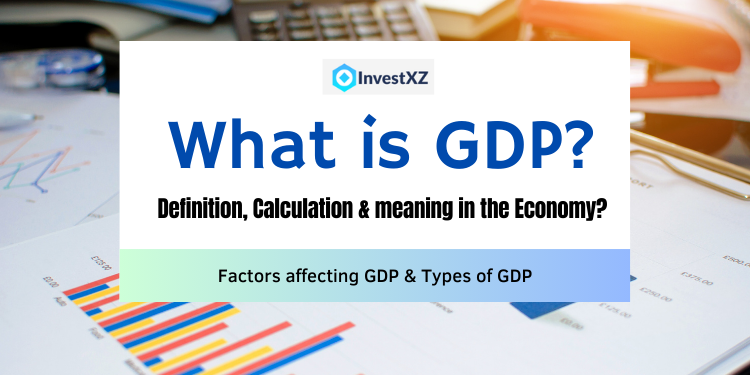When listening to the news and economic reports, you will undoubtedly frequently hear the program hosts talking about GDP. So, what is GDP, why is it important to a nation’s economy, and what is its calculation formula? Let’s see the answers below.
Contents
What is GDP? Why is GDP important in economy?
What is GDP definition?
What is the meaning of GDP?

The meaning of GDP (Gross Domestic Product) include the following:
+ Economic Output Measurement: GDP quantifies the total economic output within a specific geographic area, typically a country, over a specified period, such as a year or a quarter. It encompasses the market value of all goods and services produced within that region’s borders.
+ Indicator of Economic Health: GDP is a vital gauge of a nation’s economic well-being. It provides insights into the overall economic performance, growth, and size of an economy. Changes in GDP over time can indicate economic expansion or contraction.
+ Comprehensive Scope: GDP considers all economic activities, including the production of goods and services in various sectors such as agriculture, manufacturing, services, and more. It offers a comprehensive view of an economy’s diverse economic activities.
+ Domestic Focus: GDP focuses on economic activities that occur within a specific country’s borders. It does not consider income earned or goods produced by residents or businesses in other countries (which are accounted for in Gross National Product or GNP).
+ Frequency of Measurement: GDP is typically calculated on a regular basis, such as quarterly or annually, allowing for frequent assessment and monitoring of economic performance.
+ Comparison Tool: GDP serves as a valuable tool for comparing the economic performance of different countries or regions. It enables analysts and policymakers to evaluate and contrast the relative economic strength and growth of various areas.
+ Policy Implications: GDP data plays a crucial role in informing economic policies, fiscal decisions, and government priorities. Policymakers use GDP insights to formulate strategies for economic development, employment, and income distribution.
+ Potential Limitations: While GDP is a widely used economic indicator, it has limitations. It does not capture aspects such as income distribution, quality of life, or environmental sustainability. As a result, policymakers often consider additional metrics alongside GDP to form a more comprehensive understanding of an economy.
Main components of GDP
GDP (Gross Domestic Product) is typically calculated by summing up the main components, which represent different facets of economic activity within a country. The main components of GDP are as follows:
+ Consumer Spending (C): This component, also known as “Consumption,” represents the total expenditure by households on goods and services. It includes spending on items such as food, housing, healthcare, transportation, and entertainment.
+ Business Investment (I): Business investment, also called “Investment,” includes spending by businesses on capital goods like machinery, equipment, and structures. It also covers research and development (R&D) expenses.
+ Government Spending (G): This component accounts for the government’s expenditure on goods and services, including public infrastructure, education, healthcare, and defense. It does not include transfer payments, such as Social Security or unemployment benefits, as those do not represent the production of goods and services.
+ Net Exports (X – M): Net exports represent the difference between a country’s exports (X) and imports (M) of goods and services. If a country exports more than it imports, it contributes positively to GDP; if it imports more than it exports, it subtracts from GDP.
- Exports (X): The value of goods and services produced domestically and sold to foreign markets.
- Imports (M): The value of goods and services produced abroad and purchased domestically.
How to calculate GDP? The formula for GDP
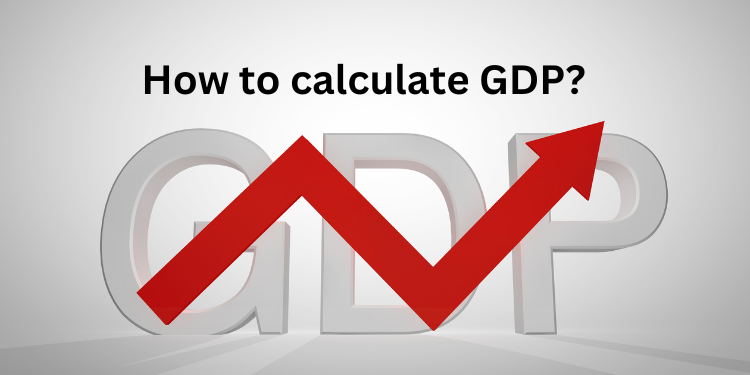
There are several approaches to calculating GDP (Gross Domestic Product), each of which provides a different perspective on the economic activity within a country. The three primary methods for calculating GDP are:
Calculate GDP base on Production Approach (Value Added Method)
This method calculates GDP by summing up the value-added at each stage of production in an economy. It involves adding up the value of all goods and services produced by various industries and sectors, subtracting intermediate consumption (the value of goods and services used up in the production process), and arriving at the final GDP figure. This approach is also known as the “value-added method.”
Formula:
GDP = Value of Output – Value of Intermediate Consumption
Calculate GDP base on Expenditure Approach (Aggregate Demand Method)
This method calculates GDP by summing up the expenditures made within an economy. It accounts for four main components:
+ Consumption (C): This includes the total expenditure by households on goods and services.
+ Investment (I): It covers spending by businesses on capital goods like machinery and equipment, as well as changes in inventories.
+ Government Spending (G): This component represents government expenditure on goods and services.
+ Net Exports (X – M): It accounts for the difference between exports (goods and services sold to other countries) and imports (goods and services purchased from other countries).
Formula:
GDP = C + I + G + (X – M)
Calculate GDP base on Income Approach (Factor Income Method)
This method calculates GDP by summing up all the incomes earned within an economy. It includes various forms of income, such as wages, salaries, profits, rents, and interest. The income approach is based on the principle that all the income generated from production must be distributed as either income to individuals or retained earnings by businesses.
Formula:
GDP = Compensation of Employees + Gross Operating Surplus (Profits) + Gross Mixed Income + Taxes on Production and Imports – Subsidies
These three approaches should theoretically yield the same GDP figure when calculated correctly, but in practice, there may be small discrepancies due to statistical differences, data collection methods, and seasonal adjustments.
Additionally, there is a “Value of Output” approach, which calculates GDP by summing the total value of goods and services produced within an economy without accounting for intermediate consumption. This approach is less commonly used than the production approach, expenditure approach, and income approach.
Factors affecting GDP
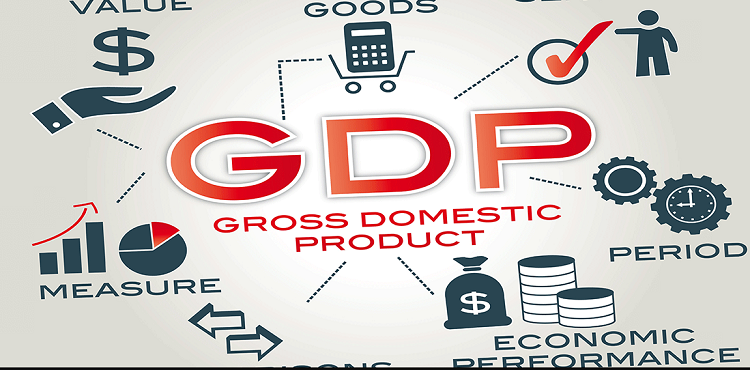
GDP (Gross Domestic Product) is influenced by a wide range of factors, both internal and external, that collectively shape the economic performance of a country. These factors can be broadly categorized into the following:
1. Consumer Spending: Consumer spending, also known as consumption, is a major driver of GDP. When consumers have confidence in the economy and their financial well-being, they tend to spend more, which boosts GDP. Factors influencing consumer spending include income levels, employment rates, interest rates, and consumer sentiment.
2. Business Investment: Investment by businesses in capital goods, machinery, equipment, and infrastructure contributes to GDP growth. High levels of business investment indicate economic confidence and often lead to increased production capacity and job creation.
3. Government Spending: Government expenditures on goods and services, such as infrastructure projects, healthcare, education, and defense, can significantly impact GDP. Government spending can stimulate economic growth during periods of recession or slow economic activity.
4. Net Exports: The difference between a country’s exports and imports, known as net exports, affects GDP. A trade surplus (exports > imports) adds to GDP, while a trade deficit (imports > exports) subtracts from it. Factors influencing net exports include exchange rates, global demand for a country’s exports, and trade policies.
5. Technology and Productivity: Advances in technology and increases in productivity can boost GDP by enabling higher output with the same or fewer resources. Innovations and efficiency improvements across industries contribute to economic growth.
6. Labor Force and Employment: The size and skills of the labor force, as well as the employment rate, are crucial factors affecting GDP. A growing labor force and low unemployment rates generally support higher economic output.
7. Monetary Policy: Central banks use monetary policy tools, such as interest rates and money supply, to influence economic activity. Lower interest rates can encourage borrowing and spending, stimulating GDP growth, while higher interest rates can have the opposite effect.
8. Fiscal Policy: Government fiscal policies, including taxation and government spending decisions, can impact GDP. Tax cuts can stimulate consumption and investment, while increased government spending can boost demand in the economy.
9. External Shocks: External events, such as natural disasters, political instability, global economic crises, and pandemics (e.g., COVID-19), can have significant short-term and long-term effects on GDP by disrupting economic activities and supply chains.
10. Consumer and Business Confidence: The confidence of consumers and businesses in the economy can influence their spending and investment decisions. High confidence levels tend to encourage economic activity, while low confidence can lead to cautious behavior.
11. Global Economic Conditions: Economic conditions in other countries can affect a nation’s GDP through trade, investment, and financial market linkages. A slowdown in major trading partners’ economies, for example, can reduce demand for exports.
12. Government Policies and Regulations: Government policies, including regulations, tax laws, and trade agreements, can impact business operations, trade, and overall economic activity, influencing GDP growth.
13. Inflation: Moderate inflation can be a sign of a healthy economy, but excessively high inflation can erode purchasing power and disrupt economic stability, affecting GDP.
Most common GDP types
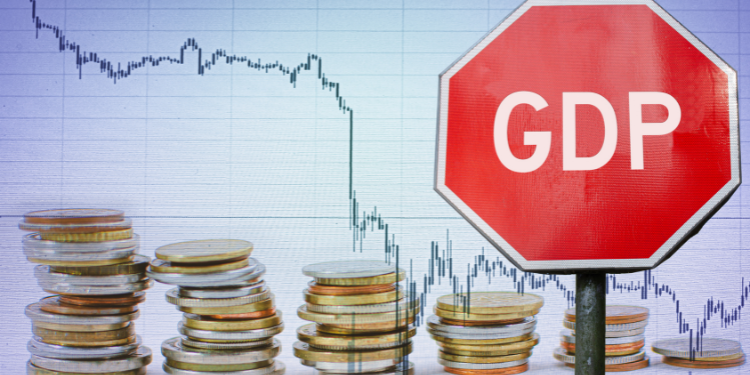
There are some kinds of GDP that you need to know:
- GDP Per Capita
- Nominal GDP
- Real GDP
What is GDP Per Capita?
GDP per capita is a valuable economic metric that provides insights into the average income or economic output per person in a country. While it is commonly used for international comparisons and assessing living standards, it is important to consider additional factors for a more comprehensive understanding of a nation’s overall quality of life and economic well-being.
The formula for calculating GDP per capita is as follows:
GDP per capita = Population/GDP
Example: Suppose you have the following data for a country:
- Total GDP for the country in a specific year = $20,000,000,000 (20 billion dollars)
- Total population of the country in the same year = 10,000,000 (10 million people)
To calculate the GDP per capita for this country:
GDP Per Capita = \frac{20,000,000,000}{10,000,000} = $2,000\;per\;person
So, the GDP per capita for this country is $2,000 per person in that particular year. This means that, on average, each person in the country earned or contributed to the economy with an amount of $2,000 during that year, assuming an even distribution of income among the population.
Key points about GDP per capita:
+ Economic Standard: GDP per capita is often used as an indicator of the standard of living or economic well-being in a country. It provides insight into how much, on average, each person in the country earns or contributes to the economy.
+ Comparison Tool: GDP per capita allows for comparisons of income levels and living standards among different countries. It helps identify disparities in income and wealth across nations.
+ Quality of Life: While GDP per capita is a useful metric, it does not provide a complete picture of a nation’s well-being. Other factors, such as income distribution, access to healthcare, education, and the cost of living, also play significant roles in determining the quality of life in a country.
+ Variations: GDP per capita can vary widely from one country to another, reflecting differences in economic development, industrialization, and income inequality. Developed countries tend to have higher GDP per capita figures compared to developing or less industrialized nations.
+ Limitations: GDP per capita has limitations, including its inability to account for income inequality within a country. In some cases, a high GDP per capita may mask significant disparities in income distribution, which can affect overall well-being.
+ Currency Conversion: When comparing GDP per capita across countries, it is important to consider currency exchange rates, as they can impact the relative values of GDP per capita figures. Adjusting for purchasing power parity (PPP) helps account for differences in the cost of living between countries.
What is Nominal GDP?
Nominal GDP represents the raw dollar value of economic activities, excluding adjustments for fluctuations in overall price levels. Therefore, shifts in Nominal GDP may stem from variations in the volume of goods and services produced (indicating real economic growth) as well as from alterations in the prices of these goods and services, which reflect inflation or deflation.
The formula for calculating Nominal GDP is as follows:
Nominal GDP=Σ (Pi×Qi)
Where:
- Pi represents the price of each good or service in the basket of goods and services.
- Qi represents the quantity of each good or service produced.
Example: Suppose you want to calculate the Nominal GDP of a hypothetical country in a specific year. You have the following data:
- Quantity of Apples Produced: 1,000,000 units
- Price of Apples: $2 per unit
- Quantity of Computers Produced: 10,000 units
- Price of Computers: $1,000 per unit
- Quantity of Services (e.g., consulting): $5,000,000 worth
- Price of Services: $100 per unit of service value
To calculate the Nominal GDP for this country in that specific year:
+ Calculate the total value of apples produced: Value of Apples = 1,000,000 * $2 = $2,000,000
+ Calculate the total value of computers produced: Value of Computers = 10,000 * $1,000 = $10,000,000
+ Calculate the total value of services produced: Value of Services = $5,000,000
=> Add up the values of all goods and services to find the Nominal GDP: Nominal GDP = $2,000,000 + $10,000,000 + $5,000,000 = $17,000,000
Key points about Nominal GDP:
+ Actual Values: Nominal GDP provides the actual, current-dollar value of an economy’s production. It is the raw GDP figure that is typically reported in the news and economic reports.
+ Inflation Impact: Changes in Nominal GDP can be affected by inflation. If the prices of goods and services increase over time, even if the quantity of production remains the same, Nominal GDP will increase.
+ Comparison Over Time: When comparing GDP figures from different years, it is important to consider the impact of inflation. An increase in Nominal GDP may not necessarily indicate real economic growth if it is primarily driven by rising prices.
+ Economic Performance: While Nominal GDP is useful for assessing the overall size and trends in an economy, it does not provide a true picture of economic well-being or changes in the volume of goods and services produced. For that purpose, economists often use Real GDP, which adjusts for inflation, to measure economic growth.
What is Real GDP?
Real Gross Domestic Product (Real GDP) is a measure of a country’s economic output or the total market value of all goods and services produced within its borders during a specific time period, typically a year or a quarter, adjusted for inflation or deflation. Unlike Nominal GDP, which is expressed in current market prices, Real GDP accounts for changes in the general price level, providing a more accurate representation of changes in the volume of goods and services produced in an economy.
Real GDP is calculated by using constant or base-year prices to remove the effects of price changes over time, allowing for a comparison of economic output across different years while holding the price level constant. This adjustment makes it possible to separate changes in economic activity (i.e., real economic growth) from changes in the prices of goods and services (inflation or deflation).
The formula for calculating Real GDP is as follows:
Real GDP= Σ(P baseyear × Qi)
Where:
- P baseyear represents the prices of goods and services in the base year (a chosen reference year).
- Qi represents the quantity of each good or service produced in the current year.
For Example:
Let’s assume you want to calculate the Real GDP for a hypothetical country in the current year (Year 2023) using prices from a base year (Year 2020). You have the following data:
Base Year (Year 2020):
+ Quantity of Apples Produced: 800,000 units
+ Price of Apples: $1.50 per unit
+ Quantity of Computers Produced: 8,000 units
+ Price of Computers: $900 per unit
+ Quantity of Services (e.g., consulting): $4,000,000 worth
+ Price of Services: $80 per unit of service value
Current Year (Year 2023):
+ Quantity of Apples Produced: 1,000,000 units
+ Quantity of Computers Produced: 9,000 units
+ Quantity of Services (e.g., consulting): $4,800,000 worth
=> To calculate the Real GDP for Year 2023:
+ Calculate the value of apples produced in Year 2023 using base-year prices: Value of Apples (2023) = 1,000,000 * $1.50 = $1,500,000
+ Calculate the value of computers produced in Year 2023 using base-year prices: Value of Computers (2023) = 9,000 * $900 = $8,100,000
+ Calculate the value of services produced in Year 2023 using base-year prices: Value of Services (2023) = $4,800,000
+ Use the base-year prices to calculate the Real GDP for Year 2023: Real GDP (2023) = (800,000 * $1.50) + (8,000 * $900) + $4,000,000 = $1,200,000 + $7,200,000 + $4,000,000 = $12,400,000
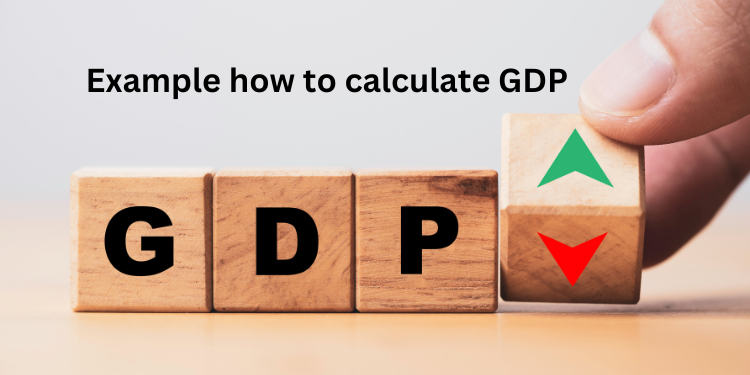
Key points about Real GDP:
+ Adjustment for Inflation: Real GDP adjusts for changes in the price level, allowing for a more accurate assessment of economic growth. It removes the impact of inflation or deflation on GDP figures.
+ Base Year: Real GDP calculations require choosing a base year with fixed prices. The choice of the base year affects the magnitude of Real GDP but not its growth rate.
+ Comparison Over Time: Real GDP is useful for comparing economic activity across different years and assessing the actual changes in production levels. It provides a more accurate picture of an economy’s growth or contraction.
+ Economic Performance: Economists and policymakers often use Real GDP to measure and analyze the true economic performance of a country, as it focuses on changes in the quantity of goods and services produced, which is a key indicator of economic well-being.
+ Nominal vs. Real GDP: The difference between Nominal GDP and Real GDP reflects the impact of changes in prices. If Real GDP is higher than Nominal GDP, it indicates that economic growth has outpaced inflation. If Real GDP is lower, it suggests that inflation has eroded economic output.
Diffirent between Nominal GDP and Real GDP
-
If nominal GDP > real GDP then the economy is inflationary
-
If nominal GDP < real GDP then the economy is deflationary
When it comes to assessing a country’s sustainable development, real GDP is more effective than nominal GDP.
In terms of the economy, controlled inflation is preferable to deflation. In other words, a situation where nominal GDP is higher than real GDP is considered better as it signifies a moderate level of inflation.
Comparative Features | Nominal GDP | Real GDP |
Definition | Nominal GDP is the total market value of all goods and services produced within a country's borders during a specific time period, expressed in current market prices. It does not adjust for inflation or deflation. | Real GDP is a measure of the total economic output of a country adjusted for inflation or deflation. It uses constant or base-year prices to remove the effects of price changes over time, providing a more accurate representation of changes in the volume of goods and services produced. |
Calculation | It is calculated by summing up the current prices of all goods and services produced in a given period. | It is calculated by summing up the quantities of goods and services produced in the current period, multiplied by their respective prices in the chosen base year. |
Impact of Inflation | Nominal GDP can be influenced by changes in both the quantity of goods and services produced (real economic growth) and changes in prices. Thus, an increase in Nominal GDP can result from economic growth, inflation, or a combination of both. | Real GDP is not influenced by changes in the price level, so it reflects changes in economic activity (real economic growth) rather than changes in prices. |
Use | Nominal GDP is primarily used to measure the actual, current-dollar value of an economy's production. It is often reported in the news and economic reports as the raw GDP figure. | Real GDP is used to assess and compare the actual changes in production levels over time, providing a more accurate measure of economic growth and contraction. It is often used for economic analysis and policy formulation. |
Comparisons Over Time | When comparing Nominal GDP figures across different years, it is essential to consider the impact of changes in the general price level. An increase in Nominal GDP may not necessarily indicate real economic growth if it is primarily driven by rising prices. | Real GDP figures allow for meaningful comparisons of economic performance across different years because they remove the impact of price changes, focusing solely on changes in the quantity of goods and services produced. |
What is GDP PPP?
Key points about GDP PPP:
♦ Purchasing Power Parity (PPP): PPP is a theory in economics that suggests that in the absence of transportation costs and trade barriers, identical goods and services should have the same price when expressed in a common currency. In other words, it reflects the exchange rate at which the same basket of goods and services has the same real purchasing power in different countries.
♦ Adjusting for Price Differences: GDP PPP adjusts a country’s GDP by considering the relative prices of goods and services in different countries. It allows for a more meaningful comparison of economic output, as it accounts for variations in the cost of living and price levels.
♦ International Comparisons: GDP PPP is commonly used to compare the economic size and living standards of different countries. It helps analysts and policymakers assess relative income levels, economic development, and standards of living on a more equitable basis.
♦ Common Currency: GDP PPP is often expressed in a common currency, such as the International Dollar (Int$), which is a hypothetical currency used for international comparisons. This allows for straightforward comparisons between countries.
♦ World Bank Data: The World Bank and other international organizations often provide GDP PPP estimates and data for countries worldwide. These estimates are based on extensive research and data collection, including price surveys.
♦ Limitations: While GDP PPP is a valuable tool for international comparisons, it has limitations. It may not capture all aspects of economic well-being, such as income distribution, non-market activities, and qualitative differences in goods and services.
Related post:
In conclusion, Gross Domestic Product (GDP) is a fundamental economic indicator that provides insights into the overall economic performance of a country. It represents the total market value of all goods and services produced within a nation’s borders during a specific time period. GDP serves as a crucial tool for assessing economic growth, size, and development.


